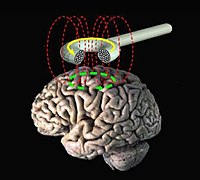
Photo from wikipedia
BACKGROUND Optimal protocol of repetitive transcranial magnetic stimulation (rTMS) on post-stroke dysphagia remains uncertain with regard to its clinical efficacy. OBJECTIVE The aim of the present study is to investigate… Click to show full abstract
BACKGROUND Optimal protocol of repetitive transcranial magnetic stimulation (rTMS) on post-stroke dysphagia remains uncertain with regard to its clinical efficacy. OBJECTIVE The aim of the present study is to investigate the effects of high-frequency rTMS at the bilateral motor cortices over the cortical representation of the mylohyoid muscles in the patients with post-stroke dysphagia. METHODS This study was a single-blind, randomized controlled study with a blinded observer. Thirty-five stroke patients were randomly divided into three intervention groups: the bilateral stimulation group, the unilateral stimulation group, and the sham stimulation group. For the bilateral stimulation group, 500 pulses of 10 Hz rTMS over the ipsilesional and 500 pulses of 10 Hz rTMS over the contralesional motor cortices over the cortical areas that project to the mylohyoid muscles were administered daily for 2 consecutive weeks. For the unilateral stimulation group, 500 pulses of 10 Hz rTMS over the ipsilesional motor cortex over the cortical representation of the mylohyoid muscle and the same amount of sham rTMS over the contralesional hemisphere were applied. For the sham stimulation group, sham rTMS was applied at the bilateral motor cortices. Clinical swallowing function and videofluoroscopic swallowing studies were assessed before the intervention (T0), immediately after the intervention (T1) and 3 weeks after the intervention (T2) using Clinical Dysphagia Scale (CDS), Dysphagia Outcome and Severity Scale (DOSS), Penetration Aspiration Scale (PAS), and Videofluoroscopic Dysphagia Scale (VDS). RESULTS There were significant time and intervention interaction effects in the CDS, DOSS, PAS, and VDS scores (p < 0.05). In the direct comparison of the changes in the swallowing parameters among the three groups, the change in CDS scores at T1 and T2 showed a significantly higher improvement in the bilateral simulation group than in two other groups (p < 0.05). There was a significantly larger change in the DOSS, PAS, and VDS scores at T1 in the bilateral stimulation group than in two other groups (p < 0.05). CONCLUSIONS The results of the present study provide substantial evidence that 10 Hz rTMS at the bilateral motor cortices over the cortical areas projecting to the mylohyoid muscles is effective as an additional treatment strategy to traditional dysphagia therapies.
Journal Title: Brain Stimulation
Year Published: 2017
Link to full text (if available)
Share on Social Media: Sign Up to like & get
recommendations!